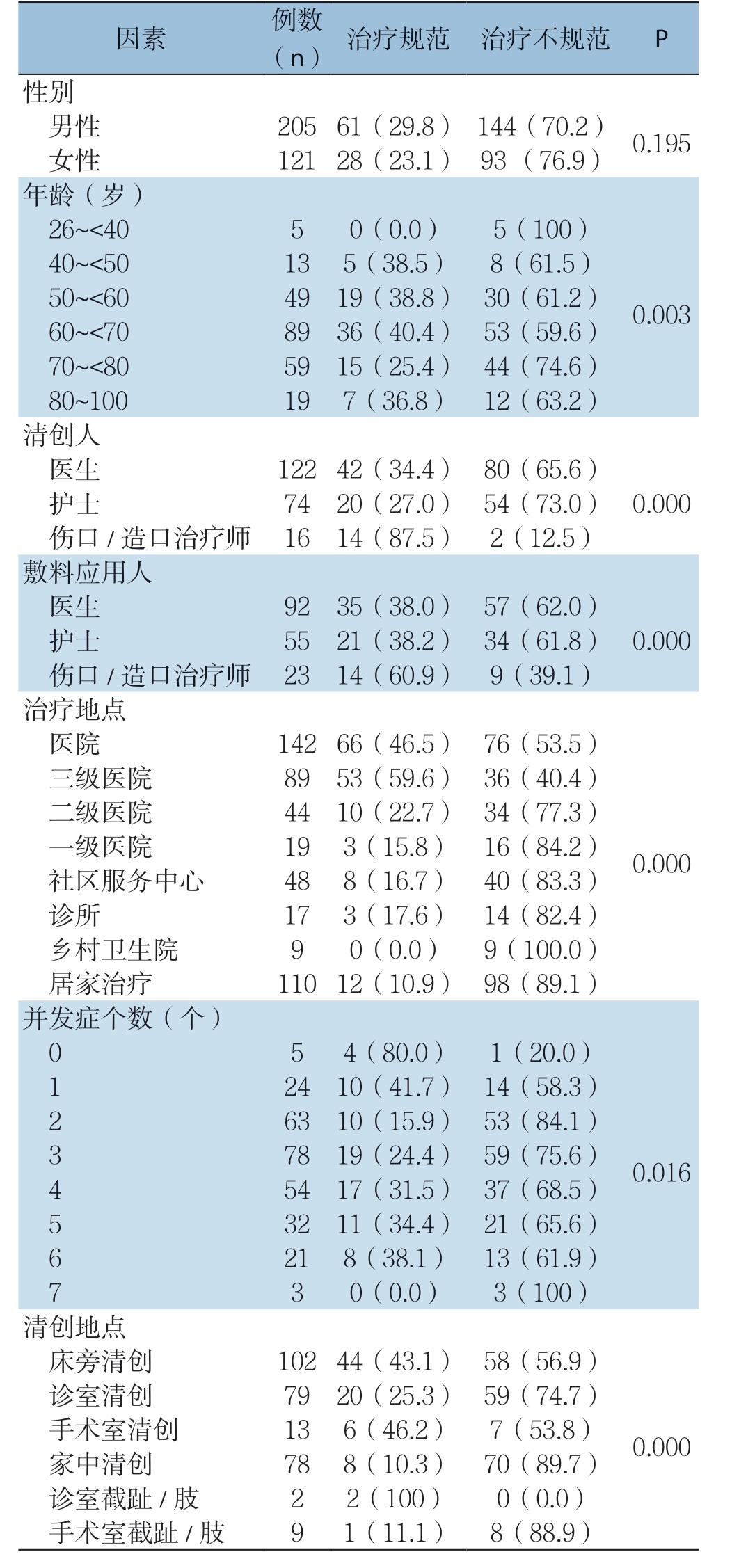糖尿病足(diabetic foot,DF)为踝关节或踝关节以下与下肢远端神经异常和不同程度的周围血管病变相关的足部感染和(或)深层组织破坏[1],是糖尿病的一种严重慢性并发症,其年发病率为8.1%、年截肢率5.1%、年病死率为14.4%[2],此外,DF患者花费巨大,约为非足病患者的2倍,给患者本人、家庭以及社会造成严重伤害和沉重的经济负担[3-4]。DF的及早诊断和规范治疗不仅能促进溃疡愈合,也是保肢的基本措施和节省医疗费用的有效途径[5-6]。以往研究[7]显示,有相当一部分住院DF患者在诊治过程中病情恶化,足溃疡加重乃至发展到坏疽、截肢。更有部分足溃疡患者由于院外治疗不当,足溃疡合并感染得不到及时处理或转诊,乃至足坏疽需要截肢才被转诊到三甲综合性医院。患者在基层医院甚至在地市级三级医院花费了大量的医疗费用,不仅没有控制病情,反而因错失最佳治疗时机而失去下肢或足[4]。因此了解规范诊治前的现状,对规范DF患者的诊疗以及医务人员专业化培训有着非常重要的意义。
本研究通过调查中国13家三甲综合医院2017年10月—11月就诊的326例DF患者,收集患者的一般资料、足部伤口情况、治疗等数据,调查DF患者在具有专业DF多学科诊疗团队的三级甲等医院就诊前的诊治现状。根据2019年《国际糖尿病足工作组糖尿病足预防和管理指南》[8],评估诊治的规范性,并探讨其相关因素,为DF患者的规范化诊疗和医务人员的专业化培训提供依据。
1 资料与方法
1.1 研究对象
本研究是采用横断面研究并使用定量的方法来收集和分析数据。研究场所是中国的湖南省、浙江省、上海市、四川省、广东省、河北省、黑龙江省、澳门选择13家具有专业DF诊疗中心的三级甲等医院,研究对象为2017年10月—11月间就诊于目标13家医院所有内分泌科的DF患者。患者的纳入标准为:⑴ 符合1999年WHO制定的糖尿病诊断标准的糖尿病患者[9];⑵ 符合1999年WHO定义的DF诊断标准[9];⑶ 符合Wagner分级1~5级[10];⑷ 知情同意者。排除标准:⑴ 患有精神疾病或意识障碍,不能和不愿合作者;⑵ 合并恶性肿瘤的患者;⑶ 伴有严重并发症不能完成调查者;⑷ 非首次在三级甲等医院专业DF诊疗中心就诊的患者。
该研究是根据赫尔辛基宣言中的指导原则进行的。涉及患者的所有程序均经中南大学的机构研究伦理委员会批准。严格遵循保密原则和自愿原则,所有参与者获得书面知情同意书。按顺序分配号码处理每个参与者的数据以维护参与者的机密性。
1.2 研究方法
问卷调查:根据2019年《国际糖尿病足工作组糖尿病足预防和管理指南》(以下简称“指南”)编制而成的DF患者就诊现状问卷。共有20个条目,分为两大部分:⑴ 患者的一般资料,包括姓名、年龄、性别、文化程度、职业、家庭人均月收入、吸烟史等;⑵ 足部伤口情况和治疗资料,包括敷料的应用、药物的局部使用、敷料使用者、伤口局部处置和处置人等。问卷由经过统一培训的调查员对符合纳入标准的患者进行问卷调查,基本资料由患者独立完成,专业相关评估由专业人员完成。对于理解有困难、文盲或者视力障碍者,由调查者协助其完成问卷。填写完整后当场回收,及时查漏补缺,保证研究质量。本研究共发放问卷340份,回收326份,有效回收率为96%。足部检查:由经过专业培训取得资格证的造口/伤口治疗师对患者进行足部检查并填写问卷,以往的治疗通过询问患者或家属和查询医疗记录获得。在本研究中,诊断是基于1999年世界卫生组织对DF的定义[9];治疗状况的评估基于指南[8],结果为诊断是否正确及治疗是否规范(表1)。
表1 DF 患者治疗情况评估表
Table 1 Evaluation items for treatment for DF patients

项目 规范 不规范伤口清洗液的选择 生理盐水或干净的清水 络合碘;碘酒;双氧水伤口局部用药 根据不同伤口的阶段选择合适的药物 抗生素;胰岛素;生长因子;烧伤膏
1.3 统计学处理
应用 SPSS22.0 软件进行数据处理,计量资料采用均数±标准差( )表示,计数资料采用频数(百分比)[n(%)]进行统计描述,采用独立样本t检验、χ2检验、多组之间的两两比较采用χ2分割法,Logistic回归分析来探索其影响因素,以及它们的分布差异。
)表示,计数资料采用频数(百分比)[n(%)]进行统计描述,采用独立样本t检验、χ2检验、多组之间的两两比较采用χ2分割法,Logistic回归分析来探索其影响因素,以及它们的分布差异。
2 结 果
2.1 患者一般资料
符合纳入标准的DF 患者326 例,平均年龄(64.83±12.36)岁;男205例(62.9%),女121 例(37.1%),其中1 型糖尿病患者9 例(2.8%)。在这些患者中,36.8%的人有吸烟史,吸烟年数范围在0~40年,平均(21.6±1.5)年。3 3.7%有足部溃疡史。Wagner 2 级患者人数最多,为108例(33.1%),Wagner 5级人数最少,5例(1.5%)。HbAlc平均值为(8.19±0.08)%,其中80.1%的患者HbAlc>7%;空腹血糖平均值(8.28±0.15)mmol/L,57.7%的人高于正常范围。
2.2 伤口诊断与治疗资料
在326例患者中,68例(20.9%)被误诊为糖尿病合并皮肤损伤,5 例(1.5%)被误诊为下肢溃疡,1 例被误诊为静脉曲张,总误诊率高达25.8%。根据统计描述的结果将患者分为治疗规范组(89例)和治疗不规范组(237例)。326例患者在进入13家三级医院前,治疗规范率仅达27.3%。两组患者在性别、年龄方面无统计学意义。在伤口清洗液的选择方面,使用络合碘作为伤口清洗液的患者最多,达123例(37.7%)。其次93例(28.5%)使用了生理盐水,16.0%选择了碘酒,12.0%的患者选择了双氧水,5.8%的患者使用了其他的清洗液(表2)。在伤口用药方面,72例(22.1%)使用抗生素,49例(15.0%)胰岛素进行局部的涂抹来治疗足部溃疡。
表2 患者伤口清洗液的选择
Table 2 The selections of wound cleaning fluid of the patients

伤口清洗液类别 n(%)络合碘 123(37.7)生理盐水 93(28.5)碘酒 52(16.0)双氧水 39(12.0)其他 19(5.8)
2.3 单因素分析结果
单因素分析结果显示,清创人、医院分级、敷料应用人、院前诊治地点、并发症个数和清创地点对患者的治疗结果有影响(均P<0.05)。被调查的患者中,大多数人之前并未在三级医院进行治疗,占到了43.6%的比例,其次,有110 例(33.7%)居家自行处理。按照医院级别,在三级医院就诊的人数最多,有89例(27.3%)。为患者进行清创最多的人是医生,有122例(37.4%),家属和患者自行处理伤口的比例合计高达34.1%,而伤口/造口治疗师处理伤口的比例仅有16 例(4.9%);在敷料应用方面,依然是医生的比例最高,为28.2%(92例),其次为家属,有83例(25.5%),伤口/造口治疗师为患者更换敷料的仅占(23例)7.1%。使用χ2分割法进一步进行比较,发现三级医院的治疗规范率高于一级、二级医院。伤口/造口治疗师的治疗规范率显著高于医生、护士、患者本人及家属(表3)。
表3 影响DF 患者治疗规范的单因素分析[n(%)]
Table 3 Univariate analysis of the factors for standard treatment of DF patients [n (%)]

因素 (例n数) 治疗规范 治疗不规范 P性别男女性性 2 1 0 2 5 1 6 2 1 8((2 2 9 3..8 1)) 1 94 34 ((77 60..92)) 0.195年龄(岁)26~<40 5 0(0.0) 5(100)40~<50 13 5(38.5) 8(61.5)5 6 0 0~~<<6 7 0 0 4 8 9 9 1 3 9 6((3 4 8 0..8 4)) 3 5 0 3((6 5 1 9..2 6))0.003 70~<80 59 15(25.4) 44(74.6)80~100 19 7(36.8) 12(63.2)清创人医生 122 42(34.4) 80(65.6)护士 74 20(27.0) 54(73.0)0.000伤口/造口治疗师 16 14(87.5) 2(12.5)敷料应用人医生 92 35(38.0) 57(62.0)护士 55 21(38.2) 34(61.8)0.000伤口/造口治疗师 23 14(60.9) 9(39.1)治疗地点医院 142 66(46.5) 76(53.5)三级医院 89 53(59.6) 36(40.4)二级医院 44 10(22.7) 34(77.3)一社级区医服院务 中心 1 4 9 8 3 8((1 1 5 6..8 7)) 1 4 6 0((8 8 4 3..2 3))0.000诊所 17 3(17.6) 14(82.4)乡村卫生院 9 0(0.0) 9(100.0)居家治疗 110 12(10.9) 98(89.1)并发症个数(个)0 5 4(80.0) 1(20.0)1 24 10(41.7) 14(58.3)2 63 10(15.9) 53(84.1)3 4 7 5 8 4 1 1 9 7((2 3 4 1..4 5)) 5 3 9 7((7 6 5 8..6 5))0.016 5 32 11(34.4) 21(65.6)6 21 8(38.1) 13(61.9)7 3 0(0.0) 3(100)清创地点床旁清创 102 44(43.1) 58(56.9)诊室清创 79 20(25.3) 59(74.7)手家术中室清清创创 1 7 3 8 6 8((4 1 6 0..2 3)) 7 7 0((5 83 9.8.7))0.000诊室截趾/肢 2 2(100) 0(0.0)手术室截趾/肢 9 1(11.1) 8(88.9)
2.4 Logistic 回归分析结果
以诊治是否规范为因变量,以单因素分析中有统计学意义的变量以及可能影响治疗规范的变量纳入自变量做Logistic多元回归分析。最终共两个因素进入了回归方程,分别为医院分级和敷料应用人。在医院分级方面,三级医院与一级医院就诊的患者治疗规范的优势比(OR)为6.707(95% CI=1.734~25.934),即三级医院DF的治疗规范率是一级医院的6.707倍,且明显优于二级医院;在敷料应用人方面,伤口/造口治疗师与患者本人治疗规范的OR 为24.117(9 5% C I=3.219~180.659),即伤口/造口治疗师的治疗规范率是患者本人的24.117倍,其治疗效果明显优于医生和护士(表4)。
表4 影响DF 患者治疗规范的多因素Logistic 回归分析
Table 4 Multivariate Logistic regression analysis of the factors for standard treatment of DF patients

因素 B S.E Waldχ2 值 df P OR(95% CI)医院分级三级医院 1.903 0.690 7.606 1 0.006 6.707(1.734~25.934)二级医院 0.209 0.745 0.078 1 0.779 1.232(0.286~5.305)一级医院 0 — — — — —敷料应用人医生 2.082 0.820 6.454 1 0.011 8.020(1.609~39.974)护士 2.130 0.885 5.800 1 0.016 8.418(1.487~47.660)伤口/造口治疗师 3.183 1.027 9.597 1 0.002 24.117(3.219~180.659)家属 1.100 0.927 1.405 1 0.236 3.003(0.488~18.492)患者本人 0 — — — — —
3 讨 论
本研究结果显示,326例患者在进入13家具有DF专业诊治中心的三级医院前,误诊率达到了25.8%,治疗规范率仅为27.3%。其中,关于伤口清洗液的选择,指南中建议“应用干净的生理盐水或清水清洗创面”,不规范率达71.5%。伤口局部用药不规范率达到37.1%。Logistic回归分析显示,医院分级是影响DF诊治水平的重要因素,三级医院DF的治疗规范率是一级医院的6.707倍,且显著优于二级医院。
由此可见,现阶段我国DF的诊治现状不容乐观,尤其是在基层医院。王飞英等[11]的研究也表明,云南省某三级甲等医院自2010—2017年收治的DF患者中,重症DF的患者82%均来源于社区医院、地州级或县级医院,由于基层医疗机构的误诊,延误治疗或治疗失当,很多病情需要在三级甲等医院就诊的患者却因为多种因素而错失诊治机会[12],最终给患者带来截肢或死亡,增加医疗费用负担。值得关注和思考的是,本研究中还有2例患者在诊室进行了截肢/趾手术。究其原因可能与基层医务人员对DF的认知与诊治水平不足,缺乏规范化诊治培训、基层医院卫生资源配置不合理、基层医疗设施不足及分级诊疗制度不完善等诸多因素有关[13-15]。这与其他慢性病基层诊疗现状的研究结果相一致[16-17]。在Li等[18-19]的研究表明,我国三级医院以下的医务人员仅10.91%的人曾接受过DF规范化治疗培训,在面对DF患者时,高达35.71%的医生和68.42%的护理人员不能正确地进行病史采集和体格检查。提示卫生行政部门,应重视优化基层医院资源配置及基础设施建设,着重加强对基层医院医务人员DF诊治的规范化培训,不断提高基层医疗机构DF管理服务能力。同时,临床亟需建立规范的双向转诊标准,通过畅通转诊渠道及建立紧密型区域医联体等多种形式促进各级医疗机构间的有效协作,合理分配医疗资源,让DF患者获取及时、匹配的诊治,以降低误诊率、改善治疗效果。
在本研究中,敷料应用人是影响规范诊治的另一重要因素,伤口/造口治疗师的治疗规范率明显高于医生、护士、患者本人和家属。伤口/造口治疗师是指从事造口护理、伤口护理、失禁护理的专业护理人才,其接受过处理伤口的正规培训,掌握了正确的治疗方法[20]。随着专科精细化的发展,专科护理的作用日益显现。研究表明,伤口/造口治疗师岗位的发展对降低住院费用、提高医疗质量、减少并发症等方面发挥了巨大的作用[21]。但是,本组研究对象中,由伤口/造口治疗师处理伤口的占比很小。说明目前在一级和二级医疗机构中,伤口/造口专科护士还未得到充分的重视和发展。国外的伤口护理专科起步早且发展已相对成熟[22-23],我国的伤口护理专科发展目前仍处于逐步发展阶段,培训体系有很多方面需要完善 [24],目前还未形成统一的专科护士准入标准,缺乏成熟的资格认定制度及机构[25]。专科护理的发展任重而道远,业界应重视对伤口专科护理人才的培养,充分发挥伤口专科护士在伤口管理中的重要作用[26],储备更多的专科性高素质人才,造福更多患者。
DF的治疗不是单一疾病的治疗,而是涉及到全身多器官、多系统的综合治疗,DF的规范化治疗和患者管理需要采取多学科诊疗的方式[27-28]。目前,多学科团队合作也在DF的诊治中发挥着重要的角色。既往研究显示,多学科诊疗模式不仅能显著降低DF患者的截肢率、溃疡的发生率和溃疡的发生率和复发率[29-31],还能改善患者预后、心理状况及生活质量,节约医疗成本[32],这也为我国DF的诊断和规范化治疗提供了思路。目前我国的DF多学科协作模式尚在探索中,大多数依托于三级甲等医院,主要针对住院患者,尚未在医联体单位进行联动,对于基层的DF患者缺乏有效的管理,而大多数的DF患者存在就诊延误的现象,故应进一步规范我国糖尿病诊治的多学科合作,壮大DF的专业诊疗队伍[33]。同时,随着人工智能的发展,智慧医疗在疾病的诊断和治疗发挥着越来越重要的作用,也拥有着广泛的前景[34-36],但目前在DF溃疡领域的研究报道甚少[37-39],值得进一步研究和探索。
本研究创新性的调查分析了三级甲等医院DF患者规范诊治前的现状,包括诊治前的规范程度和影响其规范性的因素,研究发现DF患者在进入具有专业DF多学科诊疗团队的三级甲等医院前存在误诊和治疗不规范的现象,可为之后的研究提供参考依据,以进一步加强对基层医院医务人员DF多学科规范化诊治的培训;尤其应重视造口伤口/治疗师的培养;完善基层医疗机构和三级医院DF患者双向转诊的标准;鼓励患者主动就医,以减少误诊和不规范诊治现象的发生。然而本研究仍有不足之处,该研究样本量相对较小,尤其是造口治疗师的数量较少,有待在今后的研究中进一步扩大样本量,并结合医疗信息化的发展,考虑将智慧医疗应用到DF的治疗领域,借助医联体联动以规范各级医院DF的诊治,提高诊疗效率,减少人均治疗费用,实现DF的医疗质量同质化管理。
[1] Apelqvist J, Bakker K, van Houtum WH, et al.International consensus and practical guidelines on the management and the prevention of the diabetic foot.International Working Group on the Diabetic Foot[J].Diabetes Metab Res Rev, 2000, 16(Suppl 1):S84-92.doi: 10.1002/1520-7560(200009/10)16:1+<::aiddmrr113>3.0.co;2-s.
[2] Jiang Y, Wang X, Xia L, et al.A cohort study of diabetic patients and diabetic foot ulceration patients in China[J].Wound Repair Regen, 2015, 23(2):222-230.doi: 10.1111/wrr.12263.
[3] Xu Z, Ran X.Diabetic foot care in China: challenges and strategy[J].Lancet Diabetes Endocrinol, 2016, 4(4):297-298.doi:10.1016/S2213-8587(16)00051-6.
[4] Zhou Q, Peng M, Zhou L, et al.Development and validation of a brief diabetic foot ulceration risk checklist among diabetic patients:a multicenter longitudinal study in China[J].Sci Rep, 2018,8(1):962.doi: 10.1038/s41598-018-19268-3.
[5] Nussbaum SR, Carter MJ, Fife CE, et al.An Economic Evaluation of the Impact, Cost, and Medicare Policy Implications of Chronic Nonhealing Wounds[J].Value Health, 2018, 21(1):27-32.doi:10.1016/j.jval.2017.07.007.
[6] Tchero H, Kangambega P, Lin L, et al.Cost of diabetic foot in France, Spain, Italy, Germany and United Kingdom: A systematic review[J].Ann Endocrinol (Paris), 2018, 79(2):67-74.doi: 10.1016/j.ando.2017.11.005.
[7] Petrakis I, Kyriopoulos IJ, Ginis A, et al.Losing a foot versus losing a dollar; a systematic review of cost studies in diabetic foot complications[J].Expert Rev Pharmacoecon Outcomes Res, 2017,17(2):165-180.doi:10.1080/14737167.2017.1305891.
[8] International Working Group on the Diabetic Foot.2019 IWGDF Guidelines on the prevention and management of diabetic foot disease[S].https://iwgdfguidelines.org/guidelines/guidelines/.
[9] Alberti KG, Zimmet PZ.Definition, diagnosis and classification of diabetes mellitus and its complications.Part 1: diagnosis and classification of diabetes mellitus provisional report of a WHO consultation[J].Diabet Med, 1998, 15(7):539-553.doi: 10.1002/(SICI)1096-9136(199807)15:7<539::AID-DIA668>3.0.CO;2-S.
[10] Smith RG.Validation of Wagner's classification: a literature review[J].Ostomy Wound Manage, 2003, 49(1):54-62.
[11] 王飞英, 杨莹.基层医疗机构糖尿病足诊治中存在的问题及对策[J].中华糖尿病杂志, 2017, 9(6):403-405.doi:10.3760/cma.j.issn.1674-5809.2017.06.015.Wang FY, Yang Y.Problems in diagnosis and treatment of diabetic foot in primary medical institutes and the countermeasures[J].Chinese Journal of Diabetes Mellitus, 2017, 9(6):403-405.doi:10.3760/cma.j.issn.1674-5809.2017.06.015.
[12] 郑黎强, 纪超, 岳阳阳, 等.我国县医院与三级医院人力资源现状比较[J].解放军医院管理杂志, 2018, 25(5):452-455.doi:10.16770/J.cnki.1008-9985.2018.05.016.Zheng LQ, Ji C, Yue YY, et al.Status Comparison of Hospital Human Resource between CTH and UTCH[J].Hospital Administration Journal of Chinese People's Liberation Army,2018, 25(5):452-455.doi:10.16770/J.cnki.1008-9985.2018.05.016.
[13] 周晓梅, 杨春松, 林芸竹.国内分级诊疗现状的系统评价[J].中国药房, 2017, 28(34):4763-4766.doi:10.6039/j.issn.1001-0408.2017.34.03.Zhou XM, Yang CS, Lin YZ.Systematic Review on the Current Situation of Hierarchical Diagnosis and Treatment in China[J].China Pharmacy, 2017, 28(34):4763-4766.doi:10.6039/j.issn.1001-0408.2017.34.03.
[14] 刘平良, 章海燕.我国分级诊疗的现状及对策研究[J].现代营销,2017, (10):48-49.doi:10.3969/j.issn.1009-2994.2017.10.038.Liu PL, Zhang HY.Current status and countermeasure study of hierarchical medical system in China[J].Modern Marketing, 2017,(10):48-49.doi:10.3969/j.issn.1009-2994.2017.10.038.
[15] 许雪冉, 孙强.中国分级诊疗实施现状研究[J].重庆医学, 2019,48(11):1977-1980.doi:10.3969/j.issn.1671-8348.2019.11.048.Xu XR, Sun Q.Current situation of implementation of the hierarchical medical system in China[J].Chongqing Medicine, 2019,48(11):1977-1980.doi:10.3969/j.issn.1671-8348.2019.11.048.
[16] 杜晓梅, 施心奕, 周敏, 等.金山区社区卫生服务中心住院 COPD患者诊治现状调查[J].泰山医学院学报, 2017, 38(1):13-16.doi:10.3969/j.issn.1004-7115.2017.01.004.Du XM,Shi XY,Zhou M, et a1.The preliminary research of diagnosis and treatment of hospitalized patients with chronic obstructive pulmonary disease in Jinshan District Community Health Service Centers[J].Journal of Taishan Medical College,2017, 38(1):13-16.doi:10.3969/j.issn.1004-7115.2017.01.004.
[17] 赵明利, 毕清, 桂艳丽, 等.部分基层医疗机构肺癌规范化诊治现状调查[J].医学与哲学, 2016, 37(14):95-96.doi:10.12014/j.issn.1002-0772.2016.07b.28.Zhao ML, Bi Q, Gui YL, et a1.Investigation on Standardized Diagnosis and Treatment of Lung Cancer in Partial Primary Hospitals[J].Medicine & Philosophy, 2016, 37(14):95-96.doi:10.12014/j.issn.1002-0772.2016.07b.28.
[18] 李飞霏, 程庆丰, 傅仕敏, 等.对区县医务人员糖尿病足诊疗技术培训的意义[J].中华内分泌外科杂志, 2016, 10(6):508-512.doi:10.3760/cma.j.issn.1674-6090.2016.06.016.Li FF, Cheng QF, Fu SM, et al.Exploration on technical training courses of diabetic foot among district medical clinical staffs[J].Journal of Endocrine Surgery, 2016, 10(6):508-512.doi:10.3760/cma.j.issn.1674-6090.2016.06.016.
[19] 许湘华, 谌永毅, 邹艳辉.县级医院骨干护士培训的实践与思考[J].中国护理管理, 2014, 14(1):77-79.doi:10.3969/j.issn.1672-1756.2014.001.022.Xu XH, Chen YY, Zou YH.The training practice of the core nurses from county-level hospitals[J].Chinese Nursing Management,2014, 14(1):77-79.doi:10.3969/j.issn.1672-1756.2014.001.022.
[20] 王泠, 马蕊, 郑小伟, 等.我国造口治疗师培养与使用的思考[J].护理管理杂志, 2013, 13(11):770-772.Wang L, Ma R, Zheng XW, et al.Thinking about training and utilization of enterostomal therapist in China[J].Journal of Nursing Administration, 2013, 13(11):770-772.
[21] Baich L, Wilson D, Cummings GG.Enterostomal therapy nursing in the Canadian home care sector: what is its value[J].J Wound Ostomy Continence Nurs, 2010, 37(1):53-64.doi: 10.1097/won.0b013e3181c68d65.
[22] Castledine G.The development of the role of the clinical nurse specialist in the UK[J].Br J Nurs, 2002, 11(7):506-508.doi:10.12968/bjon.2002.11.7.10154.
[23] Dutton M, Chiarella M, Curtis K.The role of the wound care nurse: an integrative review[J].Br J Community Nurs, 2014,(Suppl):S39-40.doi:10.12968/bjcn.2014.19.Sup3.S39.
[24] 韩杉, 杨文俊, 关萍, 等.造口治疗师职业发展现状调查分析[J].护理学杂志, 2019, 34(14):56-58.doi:10.3870/j.issn.1001-4152.2019.14.056.Han S, Yang WJ, Guan P, et al.Occupational status of enterostomal therapists: a questionnaire survey[J].Journal of Nursing Science,2019, 34(14):56-58.doi:10.3870/j.issn.1001-4152.2019.14.056.
[25] Yang AH, Yan M, Qin YH.The development status of specialized nursing in ostomy care both in China and abroad[J].Chin Nurs Res,2016, (3):117-120.doi :10.1016/j.cnre.2016.06.014.
[26] Johnson JA.Nursing Professional Development Specialists of the Future[J].J Nurses Prof Dev, 2016, 32(3):158-160.doi: 10.1097/NND.0000000000000251.
[27] 杨雅, 曾洁, 刘敏, 等.上海市某二级医院患者伤口特征分析[J].中国护理管理, 2014, 14(6):594-596.doi:10.3969/j.issn.1672-1756.2014.06.011.Yang Y, Zeng J, Liu M.Analysis of wound characteristics in a secondary hospital in Shanghai[J].Chinese Nursing Management,2014, 14(6):594-596.doi:10.3969/j.issn.1672-1756.2014.06.011.
[28] Salvo NL, Walsh MD, Brewster LP.Promoting Limb Salvage through Multi-Disciplinary Care of the Diabetic Patient[J].Curr Treat Options Cardiovasc Med, 2017, 19(7):55.doi: 10.1007/s11936-017-0547-1.
[29] 彭闵, 周秋红, 许景灿, 等.多学科团队诊疗模式在糖尿病足诊治中应用的进展[J].中国普通外科杂志, 2017, 26(12):1609-1617.doi:10.3978/j.issn.1005-6947.2017.12.016.Peng M, Zhou QH, Xu JC, et al.Progress on application of multidisciplinary team model in diagnosis and treatment of diabetic foot[J].Chinese Journal of General Surgery, 2017, 26(12):1609-1617.doi:10.3978/j.issn.1005-6947.2017.12.016.
[30] Lim JZ, Ng NS, Thomas C.Prevention and treatment of diabetic foot ulcers[J].J R Soc Med, 2017, 110(3):104-109.doi:10.1177/0141076816688346.
[31] Paisey RB, Abbott A, Levenson R et al.Diabetes-related major lower limb amputation incidence is strongly related to diabetic foot service provision and improves with enhancement of services:peer review of the South-West of England[J].Diabet Med, 2018,35(1):53-62.doi: 10.1111/dme.13512.
[32] Khan N, Sapsed S.Diabetes foot complication: assessing primary and secondary outcomes of multidisciplinary team versus standard care (a systematic review)[J].Int J Diabetes Dev Ctries, 2017,(37):129-136.doi: 10.1007/s13410-015-0422-0.
[33] 冉兴无, 杨兵全, 许樟荣.我国糖尿病足病的诊治现状与未来的研究方向[J].中华糖尿病杂志, 2014, 6(7):437-439.doi:10.3760/cma.j.issn.1674-5809.2014.07.001.Ran XW, Yang BQ, Xu ZR.Diagnosis and treatment of diabetic foot in China: current situation and future directions[J].Chinese Journal of Diabetes Mellitus, 2014, 6(7):437-439.doi:10.3760/cma.j.issn.1674-5809.2014.07.001.
[34] International Diabetes Federation.IDF Diabetes Atlas[M].8th ed.Belgium: Brussels, International Diabetes Federation, 2017.
[35] Dwivedi AK.Analysis of computational intelligence techniques for diabetes mellitus prediction[J].Neural Comput Appl, 2018,30(12):3837-3845.
[36] Wang SH, Zhang QJ, Huang WH, et al.A New Smart Mobile System for Chronic Wound Care Management[J].IEEE Access,2018, (6):52355-52365.doi: 10.1109/ACCESS.2018.2864264.
[37] Rubin R.Artificial Intelligence for Cervical Precancer Screening[J].JAMA, 2019, 321(8):734.doi: 10.1001/jama.2019.0888.
[38] Esteva A, Kuprel B, Novoa RA et al.Dermatologist-level classification of skin cancer with deep neural networks[J].Nature,2017, 542(7639):115-118.doi: 10.1038/nature21056.
[39] Goyal M, Reeves N, Rajbhandari S, et al.Fully convolutional networks for diabetic foot ulcer segmentation[C]//Systems, Man,and Cybernetics (SMC), 2017 IEEE International Conference,2017:618-623.
